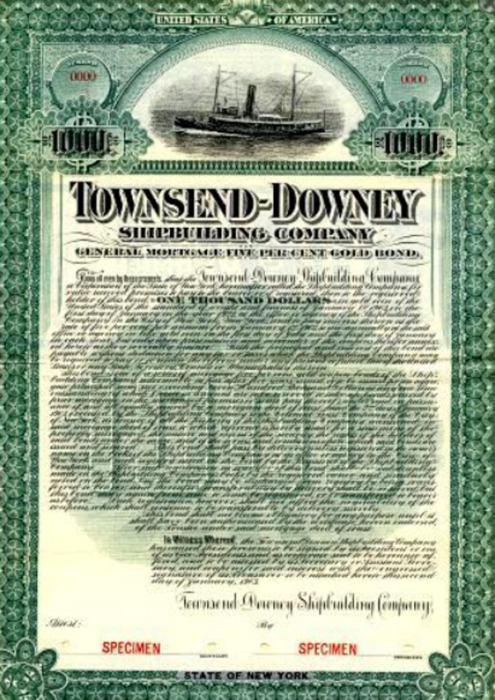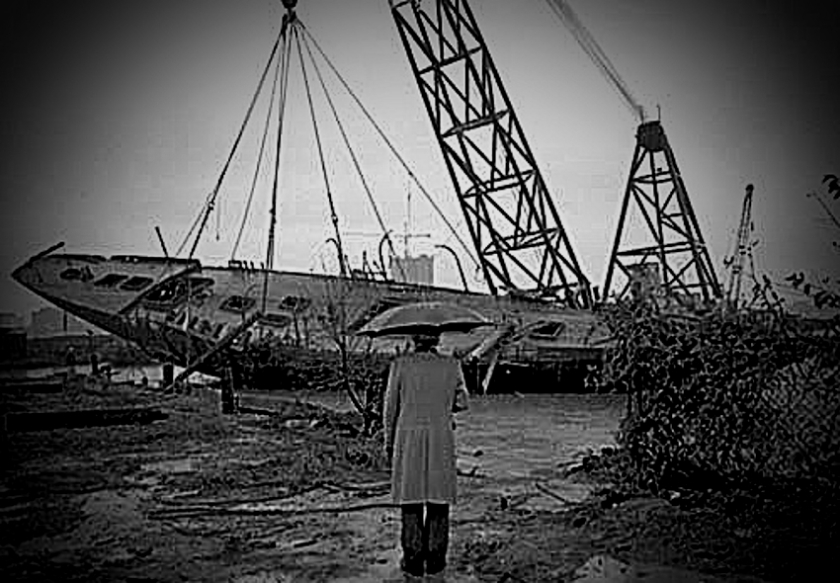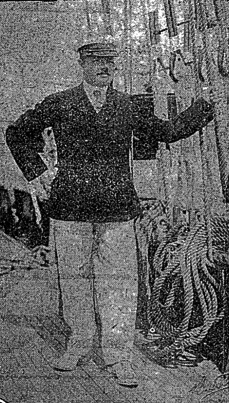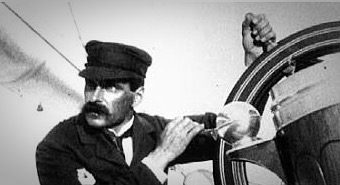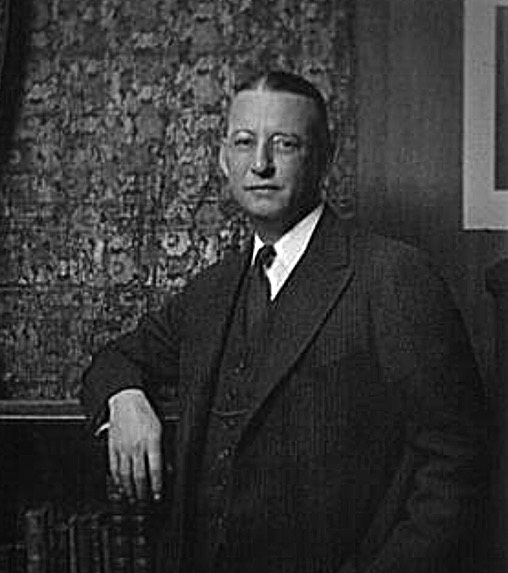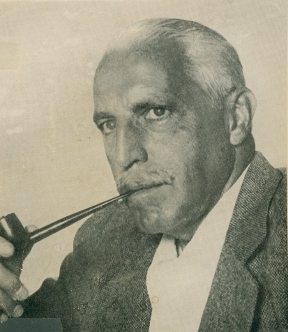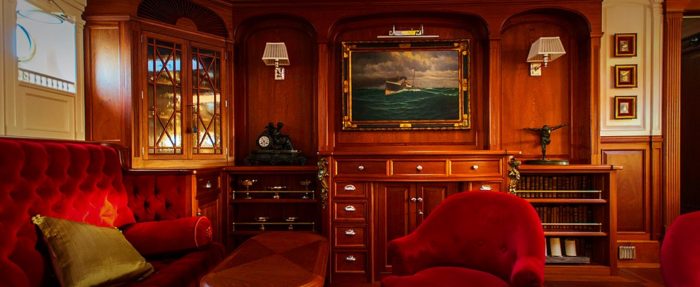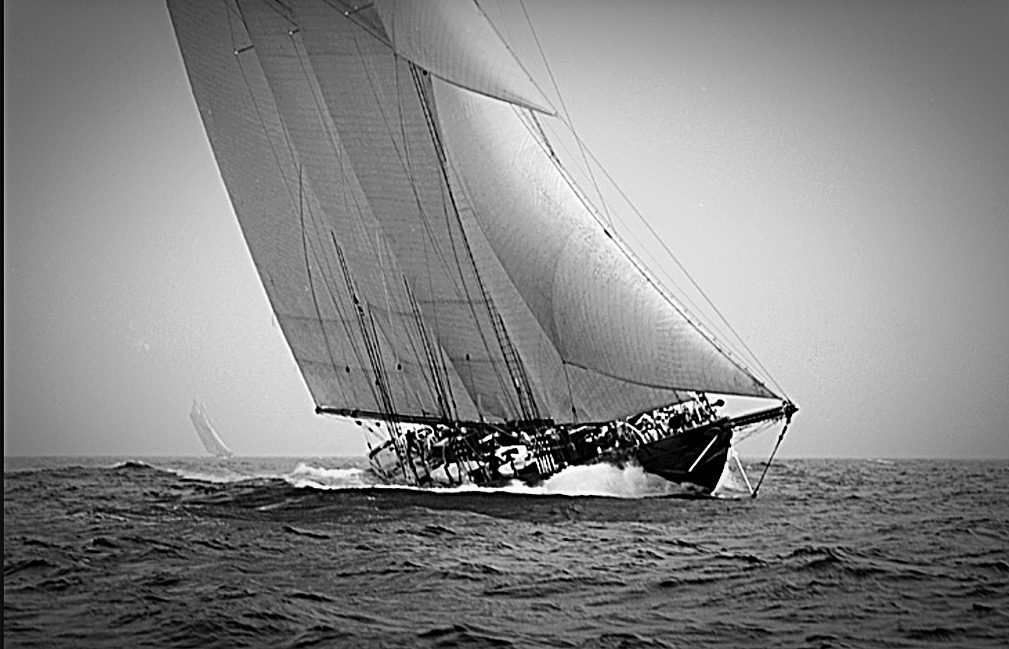
Sail Number:
Type: Three-masted schooner
LOA: 227’8″ / 69.40m – LOD: 185‘0 / 56.43m – LWL: 135’0” / 41.18m – Beam: 29’0″ / 8.85m – Draft: 16’1″ / 4.90m – Displacement: 298 Tons / 303 tonnes – Sail Area: 18,500 sq ft / 1,720 m2 – Original Owner: Wilson Marshall – Year Launched: Tuesday July 28, 1903 – Designed by: William Gardner – Built by: Townsend-Downey Shipbuilding Company – Hull Material: Wood – Status: Scraped 1982 – Honors and Awards: Kaiser’s Cup, World War I Victory Medal, American Defense Service Medal, American Campaign Medal, World War II Victory Medal
Historical:
In 1903 yachtsman Wilson Marshall, a somewhat reclusive American millionaire, and heir to his father’s Broadway Stage Line fortune, commissioned Gardner & Cox to design the Atlantic, awarding Townsend-Downey Shipbuilding Company a million dollar contract to build her. She was constructed using the most expensive materials available. Wrought-iron plating, flush riveted for her hull, with interior fittings including marble floors, bathtubs, Tiffany skylights, mahogany furnishings, gold plated faucets, and intercommunicating / submarine telephone systems, as an aide to navigation along shores and harbors. Marshall would race her under the auspices of the New York Yacht Club. as the largest private yacht of her day ending up 187’/ 57m overall, with three masts and displacing 303 tonnes.
Over two hundred invited guests from New York were brought over on the steamer George Starr to witness the ceremonies. Miss Elizabeth Hélène Gardner Demarest, ten-years old at the time, christened the vessel by cutting the cord which released the traditional champagne bottle over the bow of the mighty Atlantic. A large party of prominent yachtsmen and women watched as the magnificent vessel slid from the ways running into a large freight barge, damaging her hawsers, taffrail and steel transom plate a few minutes before noon on July 28, 1903. The damage was trifling and easily repaired, at the relief of all. The event was considered to be a harbinger of good fortune, and future success…
From the moment Atlantic went to sea, it was clear that she was an exceptionally fast and beautiful schooner. When a yacht in 1903 hits twenty knots during her sea trials, she is a promising yacht, but even then nobody could imagine two years later this yacht would set a record that would stand unmatched for almost a century.
Nevertheless, whilst Wilson Marshall wanted Atlantic to be the fastest schooner on the water, he felt there was no reason to compromise on comfort. Unlike contemporary racing schooners, Atlantic was equipped with every imaginable luxury. Fitted out with the finest mahogany panelling, she had two steam driven generators to power electric lights, refrigerators and a large galley. On deck her halyard winches and primary sheet winches were also steam driven. She had two double and three single staterooms, a lobby, a large full beam saloon, a dining room, a chart & gunroom, three large bathrooms and in the deckhouse there was a comfortable observation room. She had retractable chimneys, so while under sail the below deck steam heating, lighting and refrigeration systems could keep running. Atlantic’s fo’c’sle accommodated her thirty-nine strong crew and officers, who would live aboard throughout the year.
Immediately after fitting out she made a voyage to the West Indies, and in 1904 she participated in the outside races and the squadron runs of the New York Yacht Club cruise, winning both the Cape May and Brentons Reef cup, indicating a extraordinary speed when reaching. The Atlantic was the only centerboard yacht in the 1905 Kings Cup, though her draft is such that she is practically a keel yacht, with but little actual use for the board. In 1905 she made the headlines by winning the Kaiser’s Cup, a Transatlantic race from Sandy Hook to the Lizard. Referred to as “The last Great race of Princes” the entries for this race included all the yachts that the rich and powerful from Britain and America could send to sea.
The legendary Captain Charlie Barr, who had already successfully defended the America’s Cup three times, was hired to skipper Atlantic. Charlie Barr’s determination to win was as legendary as his skills for driving the largest of yachts to the very limit. And win, he did, sailing 3006 miles in 12 days, 4 hours, 1 minute and 19 seconds. Atlantic’s 24-hour record was 341 miles, an average speed of 14,1 knots. Uncountable attempts were made to break this record but it would hold firm until 1998, the longest standing speed record in the history of yachting.
San Jose Mercury-News (May 30, 1905) “Sturdy Scnooner Piloted by Captain Barr Passes Wolf Rock With Every Stitch of Sail Set – None of Her Competitors Has Been Sighted.”
The following represents that legendary time aboard the Atlantic as told by her owner/guardian Wilson Marshall, with an introduction by James “Gordon” Bennet, Jr., publisher of the New York Herald.
The Last Great Race of Princes – May 18, 1905
About half-past six o’clock the war ship moved in and took up her position about two miles south of the Lizard Light, giving plenty of room between herself and the Atlantic to pass. The latter came on, boomed out with squaresail on her starboard side, every scrap of sail set, and drifted over the face of the sun, and the wind freshened up a bit. As the Atlantic drew nearer we could make out a big American ensign flying from her peak. With all her sail set, William Marshall’s beautiful auxiliary three- masted schooner crossed the outside line between the Lizard and the German dispatch vessel.”
“At the next moment every steam vessel within a radius of five miles, tugs, yachts, and launches began a strident concert with whistles. Captain Barr was seen leaning over the port rail of the yacht smoking a cigar. Asked what he thought of the Atlantic the captain said: “It amounts to this: I have got the best yacht afloat, next we had good leading breezes, then the crew worked nobly and you couldn’t find a better set of fellows.”
Introduction by James “Gordon” Bennet, Jr. – the New York Herald – (May 10, 1841 – May 14, 1918) was publisher of the New York Herald, founded by his father, James Gordon Bennett Sr. (1795–1872), who emigrated from Scotland. In 1866…on a bet, Gordon Bennet won the first trans-oceanic yacht race on his vessel Henrietta taking 13 days, 21 hours, 55 minutes to finish.
Owner Wilson Marshall’s Story of How the Emperor’s Cup was Won.
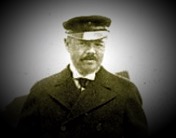
“In the busy days of preparation for this first contest for the Kaiser’s Cup, when the Atlantic was lying at anchor in the Horseshoe, I realized, in spite of my faith in my own yacht and in spite of my knowledge of the abilities of Captain Barr, his two assistants, Captain Pagel and Captain John Barr, and the crew, that such a race against such competitors was the most uncertain thing in the world. Weather, the course taken, luck, all these were potentialities to win the race, along with the boat’s capacity and the seamanship of those who sailed her. I did everything possible to make the Atlantic fit for victory, from the bottom inch of her hull to the tip of her top-masts, and then settled back to the feeling that we should do the best we could, and, whether we came in first or last, we should have a good cruise and some fine sport . Of course I wanted to win, and I wanted to see the Stars and Stripes go past the Lizard before any other flag. And when, after a day and a half’s camping on board waiting for the fog to lift, we went down to the starting-line off Sandy Hook on the morning of the 17th, there was a unanimous determination for victory on board the Atlantic, which counted, I think, during the days that followed. I think that my guests, six in number, Dr. F. B. Downs, Fred M. Hoyt, H. A. Bergmann, Morton W. Smith, L. B. Ostrander and C. B. Seeley, were all more confident of the result than I was.”

“Eleven yachts are a large number to handle at a start and there was a good deal of jockeying and close work during the few moments before the signal, but Captain Barr put the Atlantic across the line quickly, with only the Hildegarde and the Ailsa ahead of us. There was some keen racing all that afternoon, the only real racing we saw. A fine east wind was blowing and we gradually crept up on the two yachts that were leading. In a little mora than an hour we crossed the Ailsa’s lee and passed her. Then we set out to overtake the Hildegarde, and shortly after four o’clock we took her wind and went by her, while, for the moment, she stood still.
“All this time, however, we had been watching the Hamburg. The German boat had been started directly after us, and throughout our chase of the Ailsa and the Hildegarde she held on splendidly. Soon it became a duel, for all the other boats dropped away or changed their course. The wind had freshened slightly, and we had seen the Hamburg’s jib-topsail split in two and cause her crew some anxious work. All this time we did not change sail, and the Atlantic was bounding along, well in the lead. “Then a strange thing happened. For no reason that I can understand the Hamburg, as night was coming on, began to draw up on us. There had been no change in the rigging and no noticeable change in the breeze. Both yachts were heeled over, the white water hissing along the scuppers and the spray flying gloriously. Until dark it was as pretty a race as one would see, but the Hamburg gained steadily, until at last she took our weather and passed us slowly. Why there was this sudden change in the footing of the two yachts I cannot explain, unless it was that our sails in stretching were not as yet doing their full work, or that the Hamburg felt the brisker wind more advantageously. But whatever the reason, she beat us in this little preliminary race, and when the darkness hid her from us she was still ahead of us, less than a half mile to the windward.

“By this time the breeze had slackened and it began to rain. Dense fog followed. The air was damp and chilly, and bit through heavy coats, but the yacht swung along under full sail. Mr. Benedict’s yacht, the Oneida, which had been following us, disappeared toward the south. And so, quickly, with the excitement of our little brush with the Hamburg past, came the realization of the long, uncertain task that lay before us, with no noise save the purring of unseen waters under our lee rail and the sounds of the few men of us aboard. We chatted for a time and then turned in for a good night’s rest.
“I confess that I had been amused by some of the reports in the papers, reports that told of a long night’s rest we all had had Tuesday night in preparation for the many sleepless nights before us. Sleepless nights in an ocean yacht race lasting two weeks would, of course, be fatal. Sleepy heads and tired bodies bungle, and the constant keenness of the men is as necessary as the set of the sails. I had shipped a large crew—we had about fifty men aboard; there were two captains to share the care with Captain Barr; and we all lived by shifts. Our men were as fresh at the Lizard as at Sandy Hook, with the possible exception of Captain Barr, upon whom, of course, rested the greatest responsibility in the handling of the Atlantic.
“Thursday morning, shortly after daybreak, the Oneida came by us and saluted, and when the weather cleared we could see, far away in the direction in which we had last seen the Hamburg the night before, the top-masts of a yacht rigged like the German boat. There was difference of opinion aboard as to whether this was or was not the Hamburg, but since the Hamburg’s log makes no mention of sighting us that morning, and since she would have seen the Atlantic more clearly than we should have seen her, it was undoubtedly some other boat of similar rig.
“From that time on the race, as far as we were concerned, resolved itself into an ordinary cruise, except, of course, for a certain taut discipline, a more machine-like regularity, an infinitely greater anxiety to obtain the greatest possible speed consistently, a nicer calculation to keep exactly the course we had planned before the yachts left the Horseshoe, and the keen interest in the daily reckoning, in the taking of which Captain Barr and Mr. Hoyt never varied enough to make cause for argument. These alone relieved the monotony of our days, for we never again saw one of the competing yachts, and we passed fewer steamships than one meets ordinarily on a liner. The Atlantic evidently took the lead that Wednesday night after the start, and was never headed.
“All day Thursday we were on the lookout for the Hamburg, for my feeling before the race that the German boat was to be one of our most bothersome rivals had been accentuated by her showing Wednesday afternoon as we sailed out from the start. At noon we had come i65 miles of the journey (latitude 39 degrees 4o minutes, longitude 7o degrees 24 minutes, course south, 76 degrees east), and the Atlantic was doing her best with a light breeze and all sail set. Life aboard settled down to a routine. We ate and smoked and read and discussed over again the various yachts, their probable courses, their skippers and their capacities for speed. The course we had chosen for the Atlantic was not the shortest, for, it had seemed to us, the shortest route—that to the north—presented difficulties which more than equaled the gain in distance. We knew that the yachts had spread now to the various courses which they had marked out for themselves, that some were far to the north of us taking a shorter journey and that others were far to the south. Whether they were leading us was a matter which, we realized, would not be definitely known for many days. But we knew, from the speed the Atlantic was making under none too good conditions, that the yachts ahead of us, if there were any, were sailing a splendid race. And the real contest was still young.’
“That next day we added 222 miles, entirely without incident. The wind changed late Friday afternoon, but it remained light in quantity. The weather had cleared and we were in the Gulf Stream. The air was warm and balmy, and the night was glorious with bright moonlight on a gentle sea. All that evening while we watched the changing shine and shadow on the swaying water the Atlantic was proving her capacities as a light-weather boat. Indeed, she seemed to me to tiptoe across that endless field of moonshine, so silently and swiftly did she sail.
“The evening was only a forerunner of the day. Saturday morning was fine, with a splendid breeze from the west. The sun was hot and the temperature went up to summer heat during the morning. We were making good time under full sail, and a spinnaker. At noon we found that the day’s run had been 229 miles (latitude 2o degrees 45 minutes, longitude 60 degrees 38 minutes, course north, 82 degrees east).
“Before three o’clock the wind had veered to the southwest and we went faster without the spinnaker. Smoke appeared on the horizon before us, and two hours or more later we signaled the Minnitonka of the Atlantic Transport line, bound for New York. AH this time we were bowling along finely, but at half-past seven we saw black clouds racing up in the northwest and soon we began taking in topsails. Shortly after eight the squall reached us, driving a heavy rain across the decks. Everything was quickly made snug, however, and after some fitful blowing the wind died away. Up went the topsails again, so that we might make the most of the light air.
“Early Sunday morning a fine breeze sprang up out of the northwest, and the Atlantic began to make up time. All the morning under a leaden sky the wind continued fresh and steady, and at noon we reckoned a good day’s run, 27o miles (latitude 4i degrees 9 minutes, longitude 54 degrees 4o minutes, course north, 85 degrees east). The sun came out bright and warm before noon, and we set balloon staysails and No. 2 jib. All the afternoon the breeze continued, but it died away gradually toward nightfall. The calm continued all night and most of the day Monday, with vagrant light breezes now and then to lift hopes and dash them again. That morning we came close to a whale which spouted contempt for our leisurely gait and hurried away. The day’s run, reckoned Monday noon, was the poorest of our cruise—ii3 miles.
“Monday night came a welcome change. After a full day of loafing a fine wind from the south set us going again. At about nine o’clock the air suddenly grew cold, and the temperature of the water, quickly taken, registered 35 degrees. The lookout, shortly after, sighted a large iceberg,. with a dense haze hanging about its crest, about a mile to the north. Early Tuesday morning we passed close to another and larger berg which looked all of a third of a mile long, and which loomed up out of the water like a side street of downtown skyscrapers.
“The morning was bright and breezy, and the crew spent an hour or two recutting the topsails, which were badly out of shape from the wrenching blows they had had. ‘I he day’s run, reckoned Tuesday noon, was 243 miles, and we were still headed slightly into the north. In the afternoon the wind, which had been from the south, freshened and hauled gradually into the south-southeast. It was fine, steady going, the yacht heeled over and every sail working to its utmost. All night long the wind continued, growing stronger toward morning, and Wednesday morning we were racing along in a comparatively smooth sea and with the wind whistling merrily in the rigging. Great care was taken with the reckoning that noon, the many who took it uniting on a day’s run of 341 miles (latitude 44 degrees 57 minutes, longitude 39 degrees 5o minutes, course north, 65 degrees east), which is the new record for sailing-yachts, the previous record being that of the Dauntless, 328 miles. This, besides being a record, made up some of the ground we had lost during our bad day Monday, and increased our confidence for the final result.
“Late Wednesday afternoon, the breeze continuing to freshen, we reefed the spanker, and later took in both the spanker and the flying-jib. The water roughened rapidly and soon the Atlantic was plowing along with the spray spurting over her bow. By nightfall it was a very stiff breeze and the sea was running high. All night the blow lasted, and all day Thursday the fine sport continued. We were well reefed, but were carrying every ounce of sail that seemed safe. Thursday noon the day’s run stood 282 miles dead reckoning (latitude 46 degrees 33 minutes, longitude 33 degrees 3o minutes, course north, 7o degrees east). In the afternoon the sea and wind continued to increase, and we set trysails on the fore and mizzen, and had oil-bags over the bow. Time and again the waves washed the deck and foamed noisily in the scuppers. We were making good headway and took no unnecessary risks. There was no danger except of a fall on the slippery deck, and the panorama of the running sea was a great sight. It was fine sailing, the kind to make one glad one is alive. The Atlantic behaved as I have seen her behave before under similar conditions, riding the sea easily, never wrenching nor slapping. Her critics who call her merely a light-weather boat should have seen her that night and the next morning.
“All day Friday the blow continued, with high seas breaking into white crests all about us. We had oil-bags along the starboard side, and sailed under square sail and fore trysails. The day was an exhilarating one, the sea often came over.the side, and for 3 time we had the steersmen lashed to the wheel to make sure of their safety. The yacht shaped up splendidly, and Captain Barr handled her with all his accustomed skill. The day’s run, reckoned Friday noon, was 268 miles (latitude 45 degrees 58 minutes, longitude 26 degrees 48 minutes, course north, 71 degrees east).
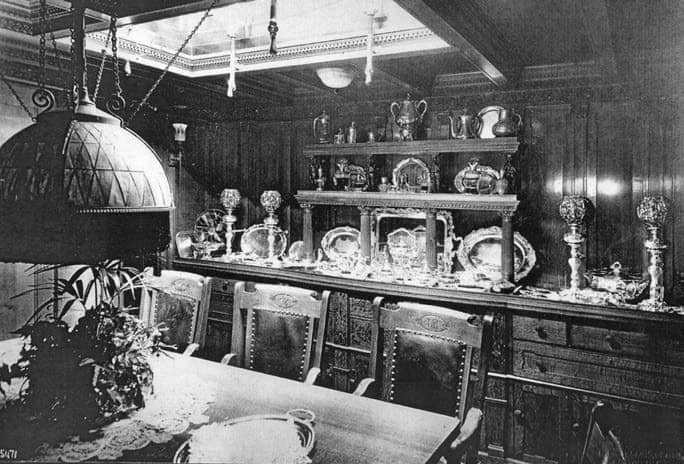
“This fine, exciting bit of sailing lasted till the middle of the forenoon Saturday. Saturday was clear ami bright, and the wind and sea gradually diminished. Soon we put on more sail and began to shake out the reefs. The day’s run, Saturday noon, was 239 miles (latitude 48 degrees 56 minutes, longitude 2o degrees 53 minutes, course north, 76 degrees east), good going considering the sea and the small amount of canvas spread. Slowly the breeze went down and by nightfall it had veered around to our quarter and, though still steady, had not half the force of the early morning. We realized that we were well toward the end of our journey, and were keeping a sharp lookout for any of the other yachts. The Atlantic was in fine shape for a good race in if any of our rivals appeared. But we saw no vessel of any kind till Sunday afternoon.
“Sunday morning we had at first a good breeze from the southwest, but the wind was fitful, at times coming in brisk squalls that bent us well over and then dying aw:ay into lighter air. The day’s run was a good one, 313 miles (latitude 49 degrees, 52 minutes, longitude 13 degrees 2 minutes, course north, 8o degrees cast). Shortly after noon a steamer appeared behind us and passed us late in the afternoon with considerable difficulty, gaining little more than a mile an hour, for the Atlantic was making the most of the wind which had now steadied considerably and was sending us along at a smart pace.
“Monday morning we were up early, for we knew that we were fairly certain of crossing the line that day, and we were all ready for a final race to the Lizard. It was fine and clear and a very light breeze was blowing, but no yachts appeared. Soon we saw the Scilly Islands, but the wind died away to a dead calm and we drifted slowly, monotonously toward the goal. The day’s run at noon amounted to 282 miles. All that morning we were watching the westward horizon for sails, and it was not until an English vessel came out to us and told us that we were the first yacht in that the suspense was relieved. We did some cheering then, every one on board joining. We had every inch of sail spread, but the canvas shook in the idle air as we slowly drifted in. A little puff of wind helped us along occasionally, and at last convoyed by many friendly vessels we slipped past the Pfcil—the German cruiser which acted as stake-boat—in the brightness of the Lizard light and to the sound of a salute from one of the cruiser’s guns and the whistles of neighboring tugs and launches. We set off our signal lights and did some more cheering, and it was all over. It was a little after eight in the evening, Monday, May the 29th. We kept on up the Channel to Southampton and docked there early Wednesday morning.
“Nothing can be surprising about a long ocean race between yachts, but the most surprising thing to me, after seeing the Hamburg’s fine sailing qualities off Sandy Hook, was that we beat her by nearly a day. Her poorest day—142 miles—was, I notice, not as poor as our calm Monday when we covered only 113 miles.

“Of course I am proud of the Atlantic. and I believe in her thoroughly. She met all kinds of weather on the way across, and made good speed out of everything except a flat calm. Captain Barr sailed her splendidly—as of course, every one expected he would—and his assistants and the crew worked with him like a machine. My guests were not only good company, but were helpful as well in time of need. And, aside from the race, we had some fine, exciting sport and an exceedingly pleasant cruise. Every one has been very kind and friendly over our victory, Americans, Englishmen and Germans alike.”
Thus the Atlantic finished first in 12 days 4 hours and 1 minute at an average speed of 10.6 knots for the 3,099 miles sailed. She beat the second boat, Hamburg, 22 hours 5 minutes; Valhalla, 1 day 22 hours 52 minutes; Endymion, 2 days 18 minutes; Ilildegarde, 2 days 52 minutes; Sunbeam, 2 days 2 hours 24 minutes; Flcur dc Lys, 2 days S hours 32 minutes; Ailsa, 2 days 7 hours 9 minutes; Utowana, 2 days 7 hours 5o minutes; Thistle, 2 days 15 hours 28 minutes.
It is instructive to compare Atlantic’s average speed with that of other famous across-ocean races. The following comparison is described by yachts name, build year and best average 24hr day speed and miles traveled.
HENRIETTA (1866) 9.36 – 280 – FLEETWING (1866) 9.16 – 260 – VESTA (1866) 9.14 – 277 SAPPHO (1869) 9.66 – 316
CORONET 1887 8.06 – 291 – DAUNTLESS (1887) 7.67 – 328 – VIGILANT (1894) 8.52 – 256 – YAMPA (1897) 8.00 – 283 – ENDYMION 1900 9.66 – 298 – INGOMAR (1904) 8.25 – 260 – ATLANTIC (1905) 10.31 – 341
Perhaps the most notable feature of the race, next to Atlantic’s good work, was the crossing of ten of the eleven owners on their own boats.

The solid gold Kaiser Cup trophy, for wining the race, become a hated reminder of why Mr. Marshall’s son had died during World War I, having had his vessel and son shipped off to war. Mr. Marshall decided to donate the Cup in order to raise funds for the Red Cross, which had at the time dealt with the War and ongoing pandemic. The trophy was auctioned off, re-donated, then re-auctioned off several times, before, at a Red Cross rally at the Metropolitan Opera House, in New York City. Anyone who donated five-dollars could come on stage to witness the cup’s destruction. The mangled remains were then sent off to a jeweler to be melted down and sold to raise even more money for the Red Cross. Upon testing the metal for purity, the jeweler found it almost pure-pure pewter, worth about $35 dollars. The Kaiser’s ruse, however, had backfired because the fools gold cup had ended up raising more than $125,000 (1940s) dollars for the Red Cross.
The Legend of Captain Charlie Bar – A 14 minute video including coverage of the Emperor’s Cup race, with some new and old pics mixed in.
World War I Service (The 5th Naval District.) USS Atlantic II (SP 651)
Following the United States declaration of war on Germany in April 1917, Atlantic was acquired by the Navy on 10 June 1917 and commissioned as USS Atlantic II (SP 651) on 28 July 1917 with Lieutenant Charles Stanley Keller, USN-USNA Class of 1907 in command (1917-1918), and Lieutenant Carroll William Hamill, USN-USNA Class of 1916 in command (1918-1919)
She was assigned to Patrol Force, Atlantic Fleet, and cruised along the east coast until November 1917 when she was assigned duty as a guard ship at Yorktown, Va., and tender to a squadron of submarine chasers. In January 1919 she was assigned to the 5th Naval District.
She was decommissioned on 11 June 1919 at the Norfolk Navy Yard in Portsmouth, Virginia. She was reclaimed by the Brady’s on 24 July 1919.
World War II Service (1st Naval District) USCGC Atlantic (WIX 271)
Atlantic was gifted to the US Coast Guard on 1 April 1941, a full eight months before Pearl Harbor. Commissioned as an auxiliary sail training ship, USCGC Atlantic (WIX-271) she served alongside the exiled Danish training ship Danmark at the Coast Guard Academy in New London, helping to train thousands of guardsmen during the war. Following the end of the conflict, Atlantic was decommissioned a second time and was decommissioned on 27 October 1947 and sold to a private owner on 10 September 1948.
Later Years:
By 1947 the Atlantic was decommissioned and sent to United Boat Service Yard at City Island in New York to be sold but she never was. After sitting for years with no buyer, the UBSY decided to sell her to a Delaware scrap yard.
Ward Bright, a yachtsman from Wildwood, saw the boat at the scrap yard, and decided to purchase her in 1953. Once in Wildwood, Bright fixed up The Atlantic and made her into a floating tea room at the marina next to the George Redding Bridge. Many of which could see her masts as they drove into Wildwood.
In the late 1950s she was ripped off her moorings and damaged. Bright didn’t have the money to fix her and due to neglect, she sank on December. 5, 1963, in 30 feet of water during a storm.
She was refloated on May 2nd 1969, but sunk again in 1973. At this time Genero Santos purchased the yacht and after several weeks she was refloated once again by a salvage team. Santos had envisioned The Atlantic as a sail training ship.
Everything was going well until a passing ship made too much wake. The movement of the wake caused one of the ship’s masts to come crashing down on the docks. Within a few days the ship sank for her last time.
The Atlantic was purchased and refloated once more, but this time she was scraped at a yard in Newport News Boat Harbor, Virginia on the 30th day of January 1982, after a failed attempt to turn her into a timeshare.
The only thing that remains of The Atlantic is the rudder that was last seen at the now closed Museum of Yachting in Newport, Rhode Island. Atlantic’s story continued for another seventy-seven years with ownership passing through the likes of Cornelius Vanderbilt III and Gerald Lambert. She was used as a mother ship for other racing yachts like Vanity, for America’s Cup defenders and the J-Class Yankee on her voyage to England. Her guest book included the rich and famous of the world. Simply put, she is the most famous and beloved racing schooner of all time.
Provenance (The Wall of Remembrance – The Owners, Crew & Notable Guest):
- Owner/Guardian: (1903-1914) Wilson Marshall, New York Yacht Club member, Commodore Larchmont Yacht Club (1906-1909) and heir to a New York streetcar fortune. Owners guest during the Kings Cup, Morton W. Smith (President of Morton W. Smith. Co., sailed on all Atlantic’s races.) Dr. F.B. Downs, Mr. H.A. Bergmann, Mr. L.B. Ostrander, Mr. C.B. Seely, and Mr. Frederick M. Hoyt. (Vice-Commodore Larchmont Yacht Club)
Racing Skipper: Captain Charlie Barr, under Wilson Marshall. In Sir Thomas Lipton’s words – “I can say without hesitation that Barr is the greatest helmsman to-day in racing a boat. I am convinced that the 3,000-mile sail between Sandy Hook and the Lizard. Charlie Barr never lost an inch for want of attention to his business. I have always found him watchful, ready for any shift, quick to find and take advantage of it. Atlantic’s extraordinary win is another victory for American designers, and for an American crew, but no matter how good the boat may be Charlie Barr must be given credit for getting out of her every inch of her splendid racing capacity.”
Assistant Captain: John Barr (older brother of Charlie), during 1905 Kings Cup. Was born in Glasgow, Scotland. Learned the trade of boatbuilding, built several boats which he raced successfully. Selected to command the Thistle, in her unsuccessful attempt to capture the America’s Cup in 1887. After returning home on the Thistle he decided to move his family to Marblehead, MA., where he captained numerous vessels including Clara, Gloriana, Shona, Jubilee, the last big yacht the Barr was in command.
Navigator and tactician: Frederick Maxfield Hoyt
- Owner/Guardian: (1917-1919) World War I US Navy, she was converted into a mother ship for U.S. subchasers along the eastern seaboard.

- Owner/Guardian: (1914-1924) – Nicholas Frederic and James Cox Brady, Yale University grads and heirs to their industrialist father Anthony N. Brady’s consolidated utility fortune. The same business model followed by John D. Rockefeller, Andrew Carnegie and James B. Duke in Oil, Steel and Tobacco respectively. Managing the late father’s estate and its diverse business interest and investments became full-time jobs for Nicholas and James.In the 1920s the Brady’s played an important role in the creation of what became the Chrysler Corporation. James and his brother were large shareholders and members of the board of directors of the ailing Maxwell Motor Company. The Brady brothers provided substantial funds to enable Walter Chrysler both to take over the ailing Maxwell Motor Company and to acquire Chrysler Corporation, becoming lifelong members of Chrysler’s board of directors.Brady and his brother James oversaw a vast business empire. Chairman of the board of directors of New York Edison Co., director of Anaconda Copper Mining Co., Westinghouse Electric, National City Bank, Union Carbide, and numerous other companies in the United States and Japan whose activities were primarily in utilities.James had amassed upwards of 5,000 acres across Hunterdon, Morris and Somerset counties, known as Hamilton Farm (the most palatial stable of the era). On a clear day, there was a view of the Hudson River from the windows of his 64-room Gregorian mansion.In 1912, four years after marrying his first wife Elizabeth Jane Hamilton Brady, Elizabeth died in a tragic railroad accident in Westport, Connecticut. James, who was also on the train, survived the wreckage, but in addition to his wife her two sisters and one of his also died.Two years later on October 15, 1914, Mr. Brady married Lady Victoria May Pery, daughter of the Earl and Countess of Limerick. They were married at Sea Verge, the summer estate of Brady’s brother, Nicholas in Monmouth Beach, New Jersey. Because of the war (28 July 1914 to 11 November 1918), the original wedding plans which called for the ceremony to be held at the bride’s family’s Dromore Castle were scraped. Newspapers made note of the difference in ages—Brady was 32 and his new wife was 20. Shortly after the wedding he and his brother purchased the yacht Atlantic
- Owner/Guardian: (1924-1927) – Brigadier General Cornelius “Neily” Vanderbilt III, member of the prominent American Vanderbilt family, American military officer Distinguished Service Medal (U.S. Army) Conspicuous Service Cross (New York) Order of the Crown (Belgium), inventor, engineer, yachtsman and Commodore of the New York Yacht Club (1906-1908)
- Owner/Guardian: (1927-1941) – Gerald Barnes Lambert, N. J. Acquired vessel for estimated $500,000 dollars (New York Times.) American merchandiser and advertiser who marketed his father(Jordan Wheat Lambert) and Dr. Joseph Lawrence invention of Listerine mouthwash by making bad breath a social disgrace. After graduating from Princeton and studying architecture at Columbia University, Lambert fought in World War I and then joined his father’s firm, Lambert Pharmacal Co. The firm later became Warner-Lambert Pharmaceutical (Warner-Lambert Company) Co. As president of the firm in 1923, Lambert focussed on the advertising efforts for Listerine. To carry out his advertising ideas, Lambert formed the advertising agency of Lambert & Feasley. With Lambert in charge, the pharmaceutical firm saw profits increase 60 times. Most notable advertising campaign was the reinvention of bad breath as the medical condition “halitosis” and the resultant social fears it inspired.In 1976, Rachel Lambert ‘Bunny’ Mellon (1910-2014) established a foundation intended to honor her father, Gerard Barnes Lambert (1886-1967), for his lifetime accomplishments in business and the arts. The Gerard B. Lambert Foundation was central in the development of the Oak Spring Garden Library and its contents. An American horticulturalist, gardener, philanthropist, and art collector. She designed and planted a number of significant gardens, including the White House Rose Garden, and assembled one of the largest collections of rare horticultural books. Mellon was the second wife of philanthropist and horse breeder Paul Mellon.
Captain: Abraham Aasen, master during Mr. Lambert’s guardianship.
- Owner/Guardian: (1941-1948) – World War II US Coast Guard
- Owner/Guardian: (1948-1953) – United Boat Service Yard, City Island.
- Owner: (1953) – Doan Salvage Company, Fieldsboro, N.J.
- Owner/Guardian: (1953-1969) Ward H. Bright, Wildwood, owner/operator of the Wildwood Yacht Basin. On Dec. 5, 1963, the Atlantic sank during a storm in 30 feet of water. She was serving as a ship museum and gift shop for her owner. Bright had bought her from the Doan Salvage Company in nearby Fieldsboro, N.J., saving her from the welder’s torch, and had her towed to the Wildwood yacht basin in 1953.
- Owner/Guardian: (1969) – Capt. Al Urbelis, contracted with Sollberger to attempt the salvage of the 67‐year‐old, steel‐hulled vessel. Captain Urbelis is the sailing instructor at the Seafarers International Union school at Piney Point, Md. The historic three‐masted schooner Atlantic is afloat again, thus ending 6 years in a watery grave at a dock in The Yacht Basin here. Ray Sollberger, a 40‐year‐ old scuba‐diving instructor, charter‐boat captain and a ship salvager by avocation, almost single‐handedly raised the 303‐ton, 185‐foot trans Atlantic record‐holder.
- Owner/Guardian: (1973) Genero Santos, Santos envisioned the Atlantic as a sail training ship.
The Rebirth of the Schooner Atlantic

The Schooner Atlantic Graces the High Seas Once Again
After owning, restoring, rebuilding or recreating a number of famous yachts such as Thendara, Aile Blanche, Borkumriff, Zaca a te Moana and most recently the Herreshoff racing schooner Eleonora, Dutch yachtsman Ed Kastelein planned his ultimate masterpiece: the recreation of the 3-mast schooner Atlantic.
Having set a new standard with his creation of Eleonora, Ed Kastelein built on his vast experience and has once again constructed a yacht that no-one thought would ever sail again. The project was certainly his most ambitious; with her length over deck of 185 feet (56 metres) she is the largest classic racing schooner ever to be recreated. Ed Kastelein was determined for her to be the way she was when she wrote history in 1905, her original lines were honoured to the finest detail and her sail plan is identical to that of her victorious 1905 Transatlantic Race which made her immortal in yachting history. Above all, she is again breathtakingly beautiful, turning heads wherever the wind takes her.

Atlantic’s dimensions are simply incredible; over deck she measures a remarkable 56 meters. Her graceful sheerline and long overhangs accentuate her grace while her waterline length of 42 meters and narrow beam are a promise of unmatched speed under sail. Her spars tower some 45 plus meters above the waterline and her original smaller ocean-going rig of 1,720m2 / 18,500 square feet, which was used for the 1905 Kaiser’s Cup, has been chosen for the new yacht. In comparison, her sail plan is more than two and a half times that of the already awesome J-Class yachts.
An intensive four year search Kastelein, assisted by yachting historian John Lammerts van Bueren, has gathered copies of dozens of drawings of the original ATLANTIC from various archives in the USA. The appearance of this majestic sailing craft will be identical to its predecessor and with Doug Peterson acting as consulting naval architect the authenticity aspects of her lines and floatation is guaranteed.
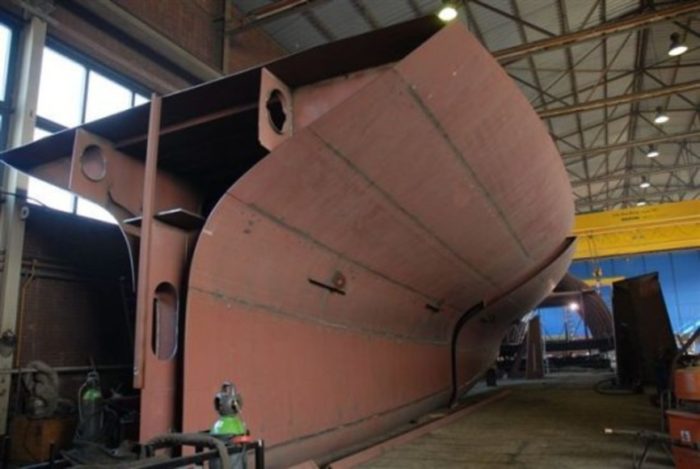
The original Atlantic was built of riveted-steel, the spars were made of solid steel tubes, she had heavy cotton sails and steam was used for propulsion. To adapt the design to actual materials and construction methods of welded hulls, lighter alloy rigs and Dacron sails, the naval architects MasterShip at Eindhoven, The Netherlands has been retained for the structural design and engineering. They completed the task of updating the design without changing an inch to the sacred aesthetics of the original.
In the old design for example all 96 steel frames were spaced at 558.8mm (20 inches) and this has been adhered to for the sake of authenticity. The revised design has resulted in a weight saving of 30 tons, without compromising the standard requirements of today’s super yachts like two Yanmar generators of 80 and 40 kWe that will provide power for the winches, air-conditioning, freezers and water makers. A Yanmar 6AY engine of 755 HP/1840 rpm has been chosen for propulsion.
The order for the hull has been granted to the Dutch yard Van der Graaf in Hardinxveld-Giessendam, who also built Eleonora. Below deck the new schooner will have considerably more comfort than the original, as eventually the yacht will serve for luxury charters. The atmosphere will be classical in which mahogany and light cream colours will predominate.
Accommodation is foreseen for twelve guests including a large master stateroom with private head and bath amidships. A modern galley will assure the catering and a pantry and laundry will provide for the household backup. The captain’s cabin is aft and crew quarters for 10 are located in the forepeak with separate deck access. In terms of space there will be no comparison with the old days when 39 crew and officers lived on board all year round.
The Dutch Van der Graaf yard first launched ATLANTIC in 2008. Following her launch, she underwent an extensive programme of fitting out. 2009 saw the assembly of her three masts.
LOA: 216’0” / 65.84m
LOD: 185‘0 / 56.43m
LWL: 135’0” / 41.18m
Beam: 29’0″ / 8.85m
Draft: 16’1″ / 4.90m
Gross Displacement: 268 tonnes
Sail Area: 18,500 sq ft / 1,720 m2
Year Officially Launched: June 23rd 2010 (gentle northerly breeze blowing.)
Designed by: William Gardiner
Built by: Van Der Graaf BV (Built to BV class and full MCA)
Hull Material: Steel
Engine: 1 X Yanmar(828HP)
Current Name: Atlantic
Original Owner: Ed Kastelein
Flag: United Kingdom (GB)
Location: Marine Traffic
Provenance (The Wall of Remembrance – The Owners, Crew & Notable Guest):
- Owner/Guardian: (2010-current) – Ed Kastelein, descendant of the founders of the “Holland-America Line”, one of the most important shipping companies in the world.
Captain: (2014) – Jim Thom
Captain: Fosse Fortuin
Resources
- Ed Kastelein SY Atlantic – https://www.schooner-atlantic.com/
- Outing Magazine (April-September 1905) Arthur Goodrich
- The Race for the Emperor’s Cup / by Paul Eve Stevenson.
- U.S. Naval Historical Center
- NavSource Online: Section Patrol Craft Photo Archive. USCGC Atlantic (WIX 271) – ex-USS Atlantic II (SP 651)
- Charles Edwin Bolles – United States Library of Congress, ID det.4a03428.
- James “Gordon” Bennet, Jr. – the New York Herald – (May 10, 1841 – May 14, 1918)
- NY Times for the 1905 article on the Kaiser’s Cup.
- Michael Redpath
- Anthony D. Blake (New Zealand) The Kaiser’s Cup: The American three-masted schooner Atlantic at the start of the Transatlantic race, 17th May, 1905
- Courtesy of the Boston Public Library, Leslie Jones Collection – BPL Accession: 08_06_005658
- Joey Contino
- Photo credit: Kees Stuip – photostuip.nl/
- Daytonian in Manhattan
- BG Cornelius Vanderbilt, III
- Chronicle of the Horse
- Ellen McGowan Biddle Shipman papers, #1259. Division of Rare and Manuscript Collections, Cornell University Library.
- Photo credit: Robert deGast, Chesapeake Bay Maritime Museum Collection. Ph 0975.0275-0281
- Princeton Magazine – Chronicles of the Rich and Famous: Gerard Barnes Lambert
- Yankee in England (1937) Gerald Barnes Lambert.
- Yachting Magazine (1966) volume 120, page 105
- Construction Photo Credit: John Lammerts van Bueren
- Oak Spring Garden Foundation: The Gerard B. Lambert Foundation
- The Academic: Lambert, Gerard Barnes
- The Wildwood Video Archive

